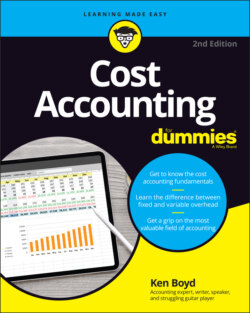Читать книгу Cost Accounting For Dummies - Kenneth W. Boyd - Страница 3
Cost Accounting For Dummies® To view this book's Cheat Sheet, simply go to www.dummies.com and search for “Cost Accounting For Dummies 2nd Edition Cheat Sheet” in the Search box. Table of Contents
Оглавление1 Cover
2 Title Page
3 Copyright
4 Introduction About This Book Foolish Assumptions Icons Used in This Book Beyond the Book Where to Go from Here
5 Part 1: Understanding the Fundamentals of Costs Chapter 1: So You Want to Know about Cost Accounting Comparing Accounting Methods Using Cost Accounting to Your Advantage Chapter 2: Brushing Up on Cost Accounting Basics Understanding the Big Four Terms Covering Costs in Different Industries Why Are You Spending? Cost Drivers Following the Rules of the Cost Accounting Road Chapter 3: Using Cost-Volume-Profit Analysis to Plan Your Business Results Understanding How Cost-Volume-Profit Analysis Works Using Cost-Volume-Profit Analysis to Make Savvy Business Decisions The Tax Man Cometh, the Profits Goeth Chapter 4: Estimating Costs with Job Costing Understanding How Job Costing Works Taking a Closer Look at Indirect Costs using Normal Costing Following the Flow of Costs through a Manufacturing System Chapter 5: More Activity, More Cost: Activity-Based Costing Avoiding the Slippery Peanut Butter Costing Slope Designing an Activity-Based Costing System Using Activity-Based Costing to Compute Total Cost, Profit, and Sale Price Implementing ABC Costing for a Business Pivot Using ABC Costing for a New Business Model
6 Part 2: Planning and Control Chapter 6: What’s the Plan, Stan? Budgeting for a Better Bottom Line Brushing Up on Budgeting Basics Planning How to Plan: Factors That Impact Your Budgeting Process The Nuts and Bolts (and Washers) of Budgeting Budgeting with Cash Accounting or Accrual Accounting Budgeting to Produce the Income Statement and Balance Sheet Chapter 7: Constant Change: Variance Analysis Variance Analysis and Budgeting Analyzing in Material Price and Efficiency Variances Using Your Findings to Make Decisions Chapter 8: Focusing on Overhead Costs Using Cost Allocation to Minimize Overhead Paying for the Security Guard: Fixed Overhead Costs Those Vexing Variable Manufacturing Costs Chapter 9: What’s on the Shelf? Inventory Costing Working with Inventoriable Costs Costing Methods for Inventory Using Variable and Absorption Costing to Allocate Fixed Manufacturing Costs Relating Capacity Issues to Inventory
7 Part 3: Making Decisions Chapter 10: Cost Drivers and Cost Estimation Methods Working with Cost Behavior Considering Cost Estimation Methods Exploring Nonlinear Cost Functions Assessing the Impact of Learning Curves Considering how AI and Data Analytics Impact Learning Curves Chapter 11: Making Smart Business Decisions with Relevant Information Navigating the Geography of Relevance Special Orders Don’t Upset Us, Do They? Deciding between Outsourcing and In-house Production Maximizing Profit When Capacity Is Limited Chapter 12: Making Smart Pricing Decisions: Figuring Total Costs Understanding Influences on Prices Pricing for Profits Down the Road Arriving at a Reasonable Profit
8 Part 4: Allocating Costs and Resources Chapter 13: Analysis Methods to Improve Profitability Processing Cost Allocation Implementing Cost Allocation Going Over Sales Mix and Sales Quantity Variances Chapter 14: Behind the Scenes: Accounting for Support Costs and Common Costs Not Everyone Generates Revenue: Support Costs Going Over Variance Analysis and Department Costs Focusing on Common Costs Making a Commitment: Contracts Chapter 15: Joint Costs, Separable Costs, and Using Up the Leftovers Working with Joint Costs Continuing Production: Computing Separable Costs After Splitoff Choosing a Joint Cost Allocation Method Holding a Garage Sale: Making the Most of Byproducts Chapter 16: Tracing Similar Products with Process Costing Process Costing: Presenting the Basic Approach Sitting on the Factory Floor: Dealing with Work in Process Using Equivalent Units to Compare Apples to Apples Using the Weighted Average Method for Process Costing Introducing the First In, First Out Method of Process Costing Comparing Processing Costing Methods
9 Part 5: Considering Quality Issues Chapter 17: What a Waste! Getting the Most from Spoilage, Scrap, and Reworked Products Accounting for Waste Applying Process Costing Methods to Spoilage Job Costing for Spoilage, Reworked Products, and Scrap Chapter 18: Making Smart Ordering Decisions Considering the Costs of Inventory Calculating Inventory Quantity with the Economic Order Quantity Formula Figuring a Favorable Reorder Point Evaluating Prediction Error Practicing Just-In-Time Purchasing SCM and Customer Demand Issues Chapter 19: Quality: Building a Better Mousetrap Considering Quality Benefits and Costs Compiling a Cost of Quality Report Putting Quality Practices in Place Customer Satisfaction: Measuring and Improving It Doing More in Less Time Eliminating the Constraint of the Bottleneck
10 Part 6: The Part of Tens Chapter 20: Ten Common Costing Mistakes and How to Avoid Them Pricing a Product Incorrectly Listing Fixed Costs As Variable Costs Labeling Period Costs As Product Costs Misusing Target Net Income Forgetting About Taxes Assigning Costs to the Wrong Product Not Reviewing Variances Correctly Redlining: Pushing Production Activity Above Relevant Range Ignoring the Timing of Costs Not Implementing Activity-Based Costing Chapter 21: Ten Ways to Increase Profits Using Costing Selling More Of The Right Products Implementing Sales Mix Analysis to Increase Total Profits Building a Higher Margin of Safety Deciding How Much You Need: Production and Scheduling Issues Who Does What: Handling Costs and Employee Issues Reducing and Managing Scrap Moving It off the Shelf: Inventory Issues Effectively Taking Special Orders Making Accurate Cost Allocations Addressing the Issue of Spoilage
11 Index
12 About the Author
13 Connect with Dummies
14 End User License Agreement
